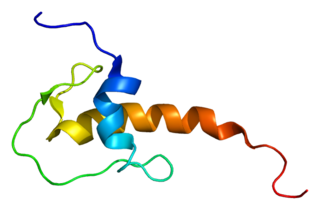
The organic compound citrulline is an α-amino acid. Its name is derived from citrullus, the Latin word for watermelon. Although named and described by gastroenterologists since the late 19th century, it was first isolated from watermelon in 1914 by Japanese researchers Yatarō Koga (古賀彌太郎) and Ryō Ōtake (大嶽了) and further codified by Mitsunori Wada of Tokyo Imperial University in 1930. It has the formula H2NC(O)NH(CH2)3CH(NH2)CO2H. It is a key intermediate in the urea cycle, the pathway by which mammals excrete ammonia by converting it into urea. Citrulline is also produced as a byproduct of the enzymatic production of nitric oxide from the amino acid arginine, catalyzed by nitric oxide synthase.

Keratin 16 is a protein that in humans is encoded by the KRT16 gene.

A disintegrin and metalloproteinase with thrombospondin motifs 2 (ADAM-TS2) also known as procollagen I N-proteinase is an enzyme that in humans is encoded by the ADAMTS2 gene.

Uroporphyrinogen III decarboxylase is an enzyme that in humans is encoded by the UROD gene.

Citrullination or deimination is the conversion of the amino acid arginine in a protein into the amino acid citrulline. Citrulline is not one of the 20 standard amino acids encoded by DNA in the genetic code. Instead, it is the result of a post-translational modification. Citrullination is distinct from the formation of the free amino acid citrulline as part of the urea cycle or as a byproduct of enzymes of the nitric oxide synthase family.

Protein-glutamine gamma-glutamyltransferase K is a transglutaminase enzyme that in humans is encoded by the TGM1 gene.

In enzymology, a protein-arginine deiminase (EC 3.5.3.15) is an enzyme that catalyzes a form of post translational modification called arginine de-imination or citrullination:

Laminin subunit gamma-2 is a protein that in humans is encoded by the LAMC2 gene.

Protein-arginine deiminase type-4, is a human protein which in humans is encoded by the PADI4 gene. The protein as an enzyme, specifically protein-arginine deiminase, a type of hydrolase.

Alpha-N-acetylgalactosaminidase is an enzyme that in humans is encoded by the NAGA gene.

Lympho-epithelial Kazal-type-related inhibitor (LEKTI) also known as serine protease inhibitor Kazal-type 5 (SPINK5) is a protein that in humans is encoded by the SPINK5 gene.

Corneodesmosin is a protein that in humans is encoded by the CDSN gene.

Histone H2A type 3 is a protein that in humans is encoded by the HIST3H2A gene.

Protein-arginine deiminase type-2 is an enzyme that in humans is encoded by the PADI2 gene.

Peptidyl arginine deiminase, type III, also known as PADI3, is a protein which in humans is encoded by the PADI3 gene.

Calmodulin-like protein 5 is a protein that in humans is encoded by the CALML5 gene.

Keratin, type II cytoskeletal 78 is a protein that in humans is encoded by the KRT78 gene.

Protein arginine N-methyltransferase 6 is an enzyme that in humans is encoded by the PRMT6 gene.

Peptidyl-prolyl cis-trans isomerase G is an enzyme that in humans is encoded by the PPIG gene.

Trichohyalin is a protein that in mammals is encoded by the TCHH gene.




















